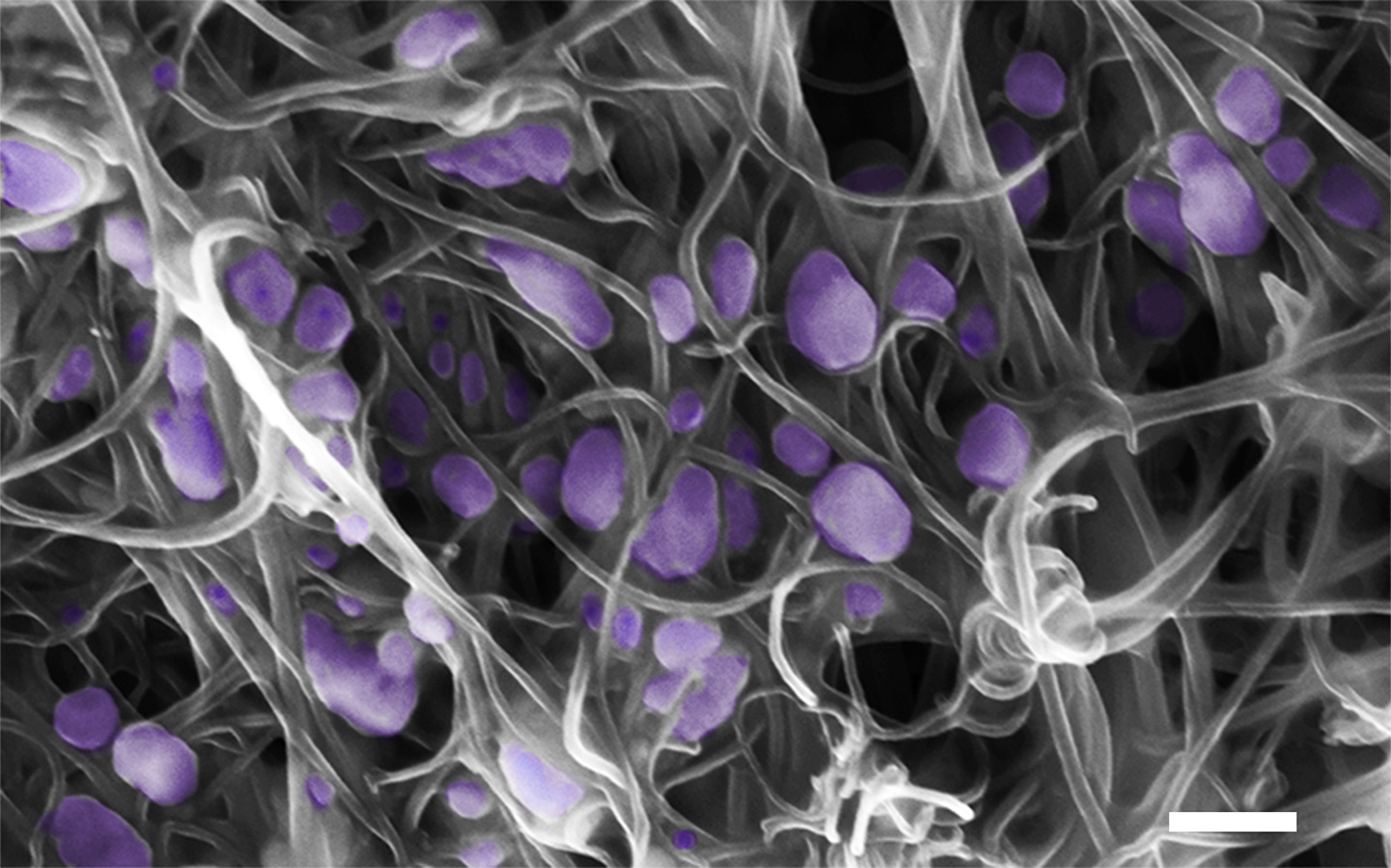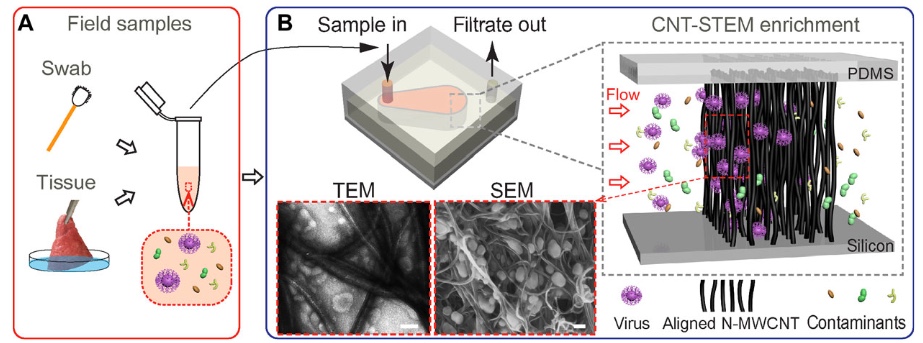A carbon-nanotube trap for ultra-sensitive virus detection and identification
October 7, 2016

Scanning electron microscope image (scale bar, 200 nm) of the H5N2 avian influenza virus (purple) trapped inside the aligned carbon nanotubes. (credit: Penn State University)
Penn State researchers have developed a new portable microdevice that uses a forest-like array of vertically aligned carbon nanotubes to selectively trap and concentrate viruses by their size. It could improve detection of viruses and speed the process of identifying newly emerging viruses.
The research, by an interdisciplinary team of scientists at Penn State, was published in an open-access paper in the October 7, 2016 edition of the journal Science Advances.
“Detecting viruses early in an infection before symptoms appear, or from field samples, is difficult because the concentration of the viruses could be very low — often below the threshold of current detection methods,” said Mauricio Terrones, professor of physics, chemistry, and materials science and engineering.
“Early detection is important because a virus can begin to spread before we have the ability to detect it. The device we have developed allows us to selectively trap and concentrate viruses by their size — smaller than human cells and bacteria, but larger than most proteins and other macromolecules — in incredibly dilute samples.”

A small, portable device increases the sensitivity of virus detection by trapping and concentrating viruses in an array of carbon nanotubes. (A) Dilute samples collected from patients or the environment are passed through a filter to remove large particles such as bacteria and human cells, then (B) passed through the array of carbon nanotubes in the device. Viruses get trapped and build up to usable concentrations within the forest of nanotubes, while other smaller particles pass through and are eliminated. The concentrated virus captured in the device can then be put through a panel of tests to identify it, including molecular diagnosis by polymerase chain reaction (PCR), immunological methods, virus isolation, and genome sequencing. The intertube distance can range from about 17 nanometers to over 300 nanometers to selectively capture viruses. (credit: Yin-Ting Yeh et al./Science Advances)
The device isolates and concentrates viruses by size, so the researchers can capture unknown viruses, said Terrones. “Once we capture and concentrate the virus, we can then use other techniques such as whole-genome sequencing to characterize it.”
Unpredictable outbreaks
Viruses such as influenza, HIV/AIDS, Ebola, and Zika can cause sudden, unpredictable outbreaks that lead to severe public-health crises. Currently available techniques for isolating and identifying the viruses that cause these outbreaks are slow, expensive, and use equipment and reagents that can be expensive, bulky, and require specialized storage.
Additionally, many recent outbreaks have been caused by newly emerging viruses for which there are no established ways to selectively isolate them for identification and characterization.
The research was funded by the U.S. National Center for Research Resources, the National Center for Advancing Translation Science, the U.S. National Institutes of Health, the U.S. Air Force Office of Scientific Research, and the Penn State Eberly College of Science, and it received support from the Penn State Huck Institutes of the Life Sciences.
Abstract of Tunable and label-free virus enrichment for ultrasensitive virus detection using carbon nanotube arrays
Viral infectious diseases can erupt unpredictably, spread rapidly, and ravage mass populations. Although established methods, such as polymerase chain reaction, virus isolation, and next-generation sequencing have been used to detect viruses, field samples with low virus count pose major challenges in virus surveillance and discovery. We report a unique carbon nanotube size-tunable enrichment microdevice (CNT-STEM) that efficiently enriches and concentrates viruses collected from field samples. The channel sidewall in the microdevice was made by growing arrays of vertically aligned nitrogen-doped multiwalled CNTs, where the intertubular distance between CNTs could be engineered in the range of 17 to 325 nm to accurately match the size of different viruses. The CNT-STEM significantly improves detection limits and virus isolation rates by at least 100 times. Using this device, we successfully identified an emerging avian influenza virus strain [A/duck/PA/02099/2012(H11N9)] and a novel virus strain (IBDV/turkey/PA/00924/14). Our unique method demonstrates the early detection of emerging viruses and the discovery of new viruses directly from field samples, thus creating a universal platform for effectively remediating viral infectious diseases.